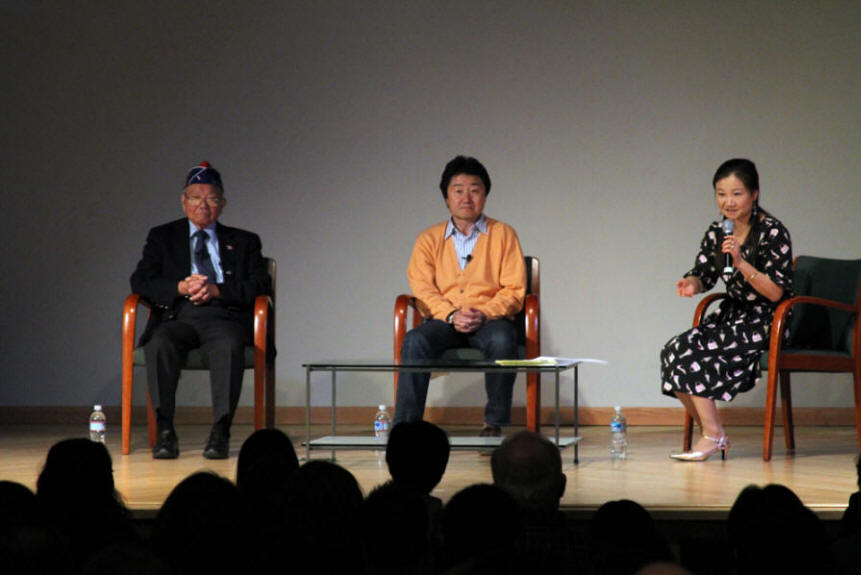
Following the showing of the film there was a 30 minute panel discussion. L-R: Terry Shima, Director Junichiro Suzuki, and Noriko Sanefuji.
Photo by Sandra Vuong.
JAPANESE AMERICAN VETERANS ASSOCIATION
(1749 Old Meadow Road; Suite 500; McLean, VA 22102)
|
IMMEDIATE RELEASE: February 25, 2010 |
Vol. VI No. 7 |
CONTACT: Terry Shima 301-987-6746; ttshima@comcast.net
PHOTO: Photo accompanies this press release.
- - - - - - - - - - - - - - - - - - - - - - - - - - - - - - - - -
442nd: LIVE WITH HONOR, DIE WITH DIGNITY SEEN BY OVERFLOW AUDIENCE AT SMITHSONIAN. DIRECTOR SUZUKI TO PRODUCE MIS FEATURE FILM
Japanese American Veterans Association
Smithsonian, Washington, DC. “Very moving,” “great,” “brought tears,” “well done,” “powerful,” “educational,” “informative,” were some of the remarks the audience wrote on their survey questionnaire following the showing of the 442nd: Live with Honor, Die with Dignity.” This film was shown at the Smithsonian Institution, Carmichael Auditorium, on February 19, 2011, sixty-nine years after President Franklin Roosevelt issued Executive Order 9066, now observed as the Day of Remembrance.
Featured in the film were Senator Daniel Inouye, Steve Shimizu, Nelson Akagi, Lawson Sakai, George Sakato and George Takei of Star Trek. The production was possible by a grant from Dr. Paul Terasaki. The narrator was Lane Nishikawa.
Following the film showing, a three person panel that included 442nd: Live with Honor, Die with Dignity director Junichi Suzuki and 442nd veteran Terry Shima and moderated by Smithsonian’s Noriko Sanefuji, discussed the film as it related to Executive Order 9066. The Smithsonian Asian Pacific American Program was the principal sponsor of the program and the co-sponsors were the National Museum of American History, National Japanese American Memorial Foundation, Japanese American Citizens League and the Japanese American Veterans Association.

Following the showing of the film there was a 30 minute panel discussion.
L-R: Terry Shima, Director Junichiro Suzuki, and Noriko Sanefuji.
Photo by Sandra Vuong.
When Nisei were recruited for the Military Intelligence Service (MIS) and the 442nd Regimental Combat Team, over 2,500 Nisei who had been forcibly relocated to barbed wire enclosed internment camps volunteered to prove their loyalty -- the only ethnic group that went into combat for that purpose in WW II.
As told by the veterans themselves and skillfully interspersed by US Army Signal Corps footage, 442nd: Live with Honor, Die with Dignity, a 97-minute film, provides rare insights of 442nd combat achievements and human nature, the effects of the war on family life, the anguish of loss of loved ones, patriotism to the land of their birth, optimism and hope for future generations, the dilemma of shooting or saving a 15 year-old enemy soldier, and the defining of the question of loyalty with unmistakable finality.
Director Suzuki, a Tokyo University graduate, served as assistant director at Nikkatsu Studio, oldest film studio in Japan. The first of Suzuki’s trilogy was Toyo’s camera: Japanese American History during WW II, a compilation of photographs of internment camp life as seen through Toyo Miyatake’s camera, a home-made box camera made of parts smuggled into camp and pieces of scrap wood. The movie, 442nd: Live with Honor, Die with Dignity, is the second of the Suzuki trilogy. Suzuki has begun film interviewing MIS veterans and Washington officials for this third film of the trilogy, a feature length film on Nisei who served in the Military Intelligence Service in the Asia Pacific Theater.
When asked about his next film project after the Military Intelligence Service filming, Suzuki responded, “the Nisei story must be told in America and Japan and our goal is not to make a profit. The Nisei experience of WW II is compelling and I am challenged and honored to bring the trilogy, as a public service, to the widest audience. After the trilogy, I believe I need to work on films that will produce income for me to live.” 30